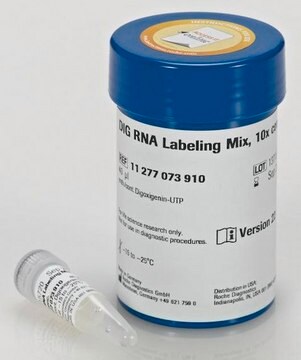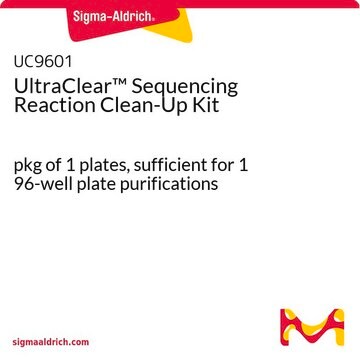S5059
SigmaSpin™ Sequencing Reaction Clean-Up
post-reaction clean-up columns
Sinónimos:
sequencing clean up columns
Iniciar sesiónpara Ver la Fijación de precios por contrato y de la organización
About This Item
Código UNSPSC:
41106300
NACRES:
NA.52
Productos recomendados
temp. de almacenamiento
2-8°C
¿Está buscando productos similares? Visita Guía de comparación de productos
Aplicación
SigmaSpin® Sequencing Reaction Clean-Up has been used in the synthesis of antisense RNA probe.
Ideal for removing dye-terminator nucleotides and primers from sequencing reactions and radiolabeled nucleotides, primers, and fluorescent dyes from nucleic acid probe labeling reactions.
Otras notas
SigmaSpin Post-Reaction Clean-Up Columns are ideal for lower throughput applications, such as clean-up of probe labeling reactions or small numbers of sequencing reactions. These columns can accept sample volumes up to 100 μL. Each column comes with a collection tube to collect the DNA during centrifugation.
SigmaSpin Post-Reaction Clean-Up columns provide a fast, simple, and highly efficient method for removing unincorporated dyes, excess salts, and other interfering reaction components. Each column is packed with a pre-hydrated size-exclusion resin, equilibrated with molecular biology grade water, and supplied in our unique column design. The column also includes a snap-cap bottom seal and an o-ring containing screw-cap to ensure that the resin remains hydrated. SigmaSpin has been tested in high-throughput genome centers and core facilities with ABI PRISM® 3700, 3100, 310 and 377. Each well can accept sample volumes up to 20 μL.
SigmaSpin Post-Reaction Clean-Up columns provide a fast, simple, and highly efficient method for removing unincorporated dyes, excess salts, and other interfering reaction components. Each column is packed with a pre-hydrated size-exclusion resin, equilibrated with molecular biology grade water, and supplied in our unique column design. The column also includes a snap-cap bottom seal and an o-ring containing screw-cap to ensure that the resin remains hydrated. SigmaSpin has been tested in high-throughput genome centers and core facilities with ABI PRISM® 3700, 3100, 310 and 377. Each well can accept sample volumes up to 20 μL.
For additional information, please see www.sigma-aldrich.com/sequencing.
Información legal
ABI PRISM is a registered trademark of Applera Corporation or its subsidiaries in the US and/or certain other countries
SabreLite is a registered trademark of Pelican Products, Inc.
SigmaSpin is a trademark of Sigma-Aldrich Co. LLC
Código de clase de almacenamiento
11 - Combustible Solids
Clase de riesgo para el agua (WGK)
WGK 3
Punto de inflamabilidad (°F)
Not applicable
Punto de inflamabilidad (°C)
Not applicable
Certificados de análisis (COA)
Busque Certificados de análisis (COA) introduciendo el número de lote del producto. Los números de lote se encuentran en la etiqueta del producto después de las palabras «Lot» o «Batch»
¿Ya tiene este producto?
Encuentre la documentación para los productos que ha comprado recientemente en la Biblioteca de documentos.
Shanshan Wang et al.
Pediatric research, 86(4), 452-459 (2018-11-24)
Urethral groove (UG) formation is an important step in penile formation. Because commonly used animal models do not have UG, the mechanisms of UG formation have never been discovered. We aim to discover the cellular mechanism of the UG formation
Seong Hyeok Cho et al.
Biochemical and biophysical research communications, 498(3), 431-436 (2018-03-03)
The goal of this study is to determine the anti-cancer mechanism of Cordycepin in A549 Cisplatin-Resistance (CR) lung cancer cells. Cordycepin inhibited the viability of A549CR cells in a dose-dependent manner. The cell inhibition was due to induction of apoptosis
Kateřina Švehlová et al.
Nucleic acids research, 44(22), 10789-10803 (2016-10-30)
A fundamental motif in canonical nucleic acid structure is the base pair. Mutations that disrupt base pairs are typically destabilizing, but stability can often be restored by a second mutation that replaces the original base pair with an isosteric variant.
High-resolution in situ hybridization to whole-mount zebrafish embryos.
Thisse C and Thisse B
Nature Protocols, 3(1), 59-69 (2008)
Ray Chang et al.
Acta biomaterialia, 111, 221-231 (2020-05-23)
Gene transfection is important in biotechnology and is used to modify cells intrinsically. It can be conducted in cell suspension or after cell adhesion, where the efficiency is dependent on many factors such as the type of nanocarrier used and
Nuestro equipo de científicos tiene experiencia en todas las áreas de investigación: Ciencias de la vida, Ciencia de los materiales, Síntesis química, Cromatografía, Analítica y muchas otras.
Póngase en contacto con el Servicio técnico





